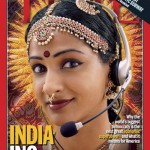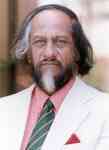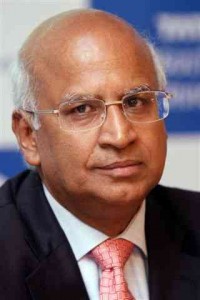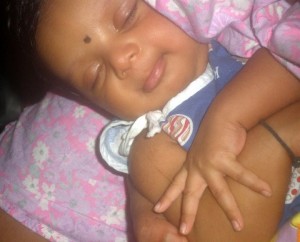Around this time every year, I eagerly wait for the annual specials from Time Magazine, be it the person of the year or the numerous other specials like the top 10 technologies of the year, top 10 films, etc. Dubbed as the ‘best and the worst lists’ they give a unique perspective on how the year has passed and what has been the high or the low points. But besides these, I really look forward to the world’s top websites listings. The reason is not all that hard to guess, because in it you will finds one of the best gems of human ingenuity, web ideas that were always there in the making except that no one did. This year’s list (www.time.com/time/specials/packages/completelist/0,29569,1918031,00.html) is no different, there are scores and scores of ideas that not only seem worthwhile (to use) but also great (to emulate). So here are a few chosen gems from the Time 50 list of best websites for 2009. If you desire more, log on to the Time site and check the complete list.
the Time site and check the complete list.
Author Archives: Shashwat D.C.
Idhant’s milestones
Raising a kid is like working on an amazing job; there might be loads and loads of fun, but at the end it is a job nonetheless. The difference is that you don’t get paid (on the contrary, you have to do so) and there is never a break from this one, no PLs, CLs, or sick leaves. There is never a time when you stop being a parent, and being on the edge becomes a habit or so. Suddenly, dust, mites, cold, fever, mosquitoes, et al become your enemies, while crocin, colimex become the trusted friends.
Are there any KRAs for the child rearing job? Of course, the difference being that they are called as milestones. These milestones usually turn into an obsession for many parents, as they do not want their ward to lag early in life. Continue reading
Interview: Dr RK Pachauri (IPCC)
“Is the climate change situation as dire as you make it sound?” Is invariably the first question that any interviewer puts to Dr. Rajendra Kumar Pachauri, chairman of the Intergovernmental Panel on Climate Change (IPCC) and the director general of The Energy and Resources Institute. Ever since 2007, when Pachauri came out with earth shattering commentary that our planet was moving rapidly towards an ecological disaster of gargantuan proportion, somewhat of an Eco-Armageddon and it was human activity that is responsible for the same; he has been hailed as a hero and reviled as a villain across the globe. Since, then Pachauri has been asked above question over and over again, and yet the environmental Nostradamus always answers the question calmly and lists down all the dangers that confront us in a solemn demeanor.
For western nations like the US that after years of releasing obnoxious pollutants in the atmosphere and wanting other nations like India and China to take a commitment first, Pachauri is a somewhat of a bogeyman. Nonetheless, he has taken a strong stance on what the world needs to do forestall the doom and how the developed countries should not merely shift the onus and blame to developing countries. In recognition of his efforts and those of IPCC, the Nobel Committee conferred on IPCC and Al Gore, the Nobel Peace Prize in 2007. In his acceptance speech on behalf of IPCC, Pachauri had invoked the Sanskrit adage, vasudev kutumbakam (the whole universe is one big family) and asked everyone to contribute to the fight against climate change.
Post Nobel, Pachauri turned into the most recognized face of climate change and he continues to invoke the same vasudev kutumbakam principle to ask all to join in the challenge. In a special discussion, he talks about the ways in which Indian corporate sector can play a significant role in battle, on CSS, nuclear energy and so many other things.
Whenever, we talk about climate change it is often from a macro perspective, namely what the governments can do on it. Do you think that at a micro level, say enterprises too have a certain amount of responsibility and can work towards a better world?
Indeed it is so. There is a whole range of things that companies and enterprises can do. The impacts of climate change are going to be very diverse, they are going to range from an increase in extreme climate events, to heat waves, drought, and also changes in precipitation pattern so the availability of natural resources like water is going to be definitely affected and it is going to impact on the working of the corporate sector. So companies need to start looking at how they need to adapt to these extreme events, for instance if there is an company that uses a large amount of water like a semiconductor fab; the water is not going to be available in the manner and to the magnitude they need in the future. So probably they need to think in terms of recycling of water, using processes that are less water intensive, etc. So these are adaptations measures that they can. And this will not only benefit the company but also go a long way in the fight against climate change.
What do you think about the eco-consciousness of the Indian corporate sector?
Well, it is growing, it is still not where it should be but I think the consciousness is growing. What is important is that there is desire to understand and to find out what they can do. But not all of them are not well informed on what the impact of climate changes are and how they should respond to it. I want to highlight the fact that the need to reduce the emission of green house gases (GHG) is also linked to energy supply because energy is going to be an issue that will affect countries, corporate entities, and even individual. The security of energy supply is certainly in question as far as the future is concerned. So to the extent that corporate sector can use energy more efficiently, perhaps to shift as much as possible to the use of renewable energy. There own security about the supply of energy will enhance. And while doing all that they will also be able to cut down on costs. They will have to carry out some due diligence, exactly define what they can do. The corporate sector in India needs to wake up to the challenge of climate change.
Right now, most of the green initiatives carried out by the corporate sector are clubbed under the CSR tag, what do you make of it?
You know, I think by and large a lot of corporate organizations treat CSR as a kind of a cosmetic effort. I don’t think that is the right spirit. CSR should be mainstream, after all if a company has to succeed it also has to ensure that the society succeeds as well. And hence, for that to happen companies need to start looking at some of these initiatives as part of their overall operating strategy, not something that you do external to the enterprise. Hence, it is essential to integrate the two.
has to ensure that the society succeeds as well. And hence, for that to happen companies need to start looking at some of these initiatives as part of their overall operating strategy, not something that you do external to the enterprise. Hence, it is essential to integrate the two.
Due to your association with TERI, you have been privy to a lot of information about the various sectors of Indian industry; what do you think about the eco-consciousness of the IT industry vis-à-vis the rest of the sectors?
Some of the IT companies are indeed getting conscious of the fact, but I am not sure whether they are doing too much about it. Even if you look at some of the buildings that they construct, they have not really paid any attention by and large to energy efficient design, reducing energy in a way to make it sustainable in terms of supply opportunity in the future. And I am not too sure whether most of them are looking at even at the hardware and the software that they use being focused on energy efficiency. So I still think that there is a long way to go and I am not singling out the IT industry, every industry and enterprise needs to gear up for the challenge. Continue reading
Farewell Rama
Received an innocuous mail from TCS today, it was regarding a press meet at their heritage building HQ in Mumbai with the CEO and MD. All seemed like yore till my eyes actually read the name N Chandrasekaran instead of the usual S Ramadorai. In fact, the mind is so accustomed to see his name, that it took a moment to realise that the change of guard that had been in the offing, is finally at hand.
Come tomorrow (October 6), the curtains will be down for one of the most illustrious CEOs of India, Subramaniam Ramadorai or S. Ramadorai as he is more universally known. The top-honcho at TCS, the $6 billion IT behemoth, will hand over the baton to his successor N Chandrasekaran (Chandra, is his appellate) and take a back seat as the vice-chairman. The handover is necessitated by the Tata Rule book that states that no individual can continue as a CEO beyond the age of 65. There have been exceptions in the past, but Rama has chosen to follow the rule-book and not take the easy way out. In fact this is one of the most defining traits of Rama as an individual and as a CEO; he never flinches to take a long arduous path if he believes it to be the right one. With a grit that only a few can match up with, Rama will keep working at the goal tirelessly, day in and day out. And yet, except for the few around him not many would realise that this calm serene sexatarian is a workaholic, who even when is calm and serene on the out, is in fact working at a frenzied pace within. Looks can be deceptive, is a phrase that would have been coined for Rama, if it wasn’t before.
It was much this grit and determination that won him the CEO cap at TCS, when the doyen of Indian IT, FC Kohli retired back in 1996. Back then, not many knew who exactly Ramadorai was or would have given him much notice, considering the fact that back then TCS was a private company and fairly secretive about its revenues and spread. In those days, for Indians IT meant Infosys or Wipro, or even HCL, but certainly not TCS. And yet, Rama who had joined TCS as a junior engineer in 1972 was destined and determined to change that. He rose through the ranks and eventually was charged with setting up TCS’ operations in the United States in 1979 in New York City, where he got an opportunity to prove his mettle.
Hailing from Nagpur, Rama grew up in Delhi where his father worked with the Indian audits and accounts service department. After studying physics at the University of Delhi, he headed south to Bangalore to study communication technology at the prestigious Indian Institute of Science. Continue reading
Caught in the slough of mammon
Media industry in India was badly hit by the global economic downturn and yet it is only their greed and ignorance that is to blame.
On a sultry February evening, the high and mighty of print media in India, namely, Indian Express’ Shekhar Gupta, HT’s Shobhana Bhartia, and TN Ninan of Business Standard dropped for a visit at Shashtri Bhavan to meet Anand Sharma, then the MoS for Information and Broadcasting.
The meeting was unusual as the triumvirate of Gupta, Bhartia and Ninan were meeting the Minister not as condescending journalists but as supplicants pleading for a bailout especially for the newspaper industry due to pressures borne out of the economic slowdown.
Apparently, the minister gave them a kind ear and promised to look into their demands. Within a few days, the government announced a stimulus package that comprised a waiver of 15% agency commission on DAVP advertisements and a 10% increase in rates for the ads released by the DAVP.
Certainly, it must have been a major embarrassment for the proud Czars of the Fourth Estate to mollycoddle the very government they are prone to stick a knife into. But ever since the tide turned in the US markets and thereby the rest of the world, the media industry in India and elsewhere has been under severe pressure in terms on increase in input costs and a massive reduction in revenues.
Not such a ‘fine print’
Indeed the inputs costs in terms of newsprint prices have really ballooned over the past year so or so– by around 60% since 2007. According to recent study done by FICCI-KPMG, the sudden escalation in newsprint prices is one of the primary reasons why the newspapers have suffered. The study estimates the print media industry to be collectively worth around Rs. 17260 crore for 2007-08, and due to the pressures from within and outside the collective growth of the industry has been pegged at a paltry 7.6% and projected to grow by some 6% in the current year. Continue reading
Hundredth Post!!!
Any batsmen worth his salt will tell you, that the most disconcerting and nerve-wrecking time at the crease is not when one opens the innings, but when the personal score is in the edgy 90s. More so, if it is 99; just a single required to cross over into the triple digit club of 100. Usually most falter that this very edge, even the mighty and so do the lowly. That’s the power of 100, it can daunt anyone. But, if you do manage to cross into the club. It is a indeed a very exhilarating experience. The feeling of being a centurion!
Thus, eversince I saw my WordPress Dashboard tell me that I had 99 posts on this blog, I was stumped. It was a great a feeling to know that in spite of all the odds, the biggest one being my own laziness and tardiness, I have indeed managed to somehow keep this one venture of mine alive, when so many others have vanished in the realms of time.
So, when it dawned on me that, I too will be a centurion blogger, namely, who has written 100 odd posts, I was all caught up in thought. It took me many many days to decide on what would be that 100th post. Since, it was to be special, I thought that I’d indeed make it very special. So, I begin thinking over it, should it be my favorite published article – but then there aren’t many of them, or should it be an unpublished one – there are just so many of them. Should it be a feature, comment, short story, interview, etc. I just kept ruminating over it.
Every passing day, whenever I would find some free time on my hand I would think on that special 100th post. It almost took me a month before I realised that in the process of trying to make my post special, I was steadily returning to my old self, wherein there is much thought and little action. Like a bolt it hit me that the 100th post will not be special because of its structure or form, but simply because it is 100th. Nothing more and little else.
So this is my 100th post, and it kind of is an announcement of my committment to shashwatdc.com. Continue reading
The cage & the corporate
She lay there in the cramped quarters waiting for the end to come. The ears pricked as the door was gruffly opened and a menacing hand appeared in search of a neck, it really did not matter whose. A flurry ensued, as everyone tried to stay clear of those grizzly fingers, feathers flew, bodies crushed, wings torn, in the maniacal rush.
Somehow, she had enough and she edged closer towards the searching fingers, only to be brushed aside. Finally, a neck was gripped, the door creened further as the unwilling body was dragged behind the neck. After some frenetic bawling, there was a snap and all went hush again; both outside and within the cage.
I wish I could console the distressed chicken and tell her that my world is not much unlike hers. I too live in a frenzied world, that is all just bothered to save its own neck. If only she knew, there is little difference between the coop and the corporate.
Ek Boond…..
‘Ek Boond’ is a poem in Hindi that has stuck with me since my schooldays. Even in those days, I liked it though I never properly could have understood its poignant subtext. The whole imagery of an unsure, nervous and jittery raindrop caught in self doubt while leaving her home in the clouds, was and is still one of the most evocative texts I have chanced upon. Little wonder then that the ‘Ek Boond’ not only found home in a waiting pearl shell but also in my heart and mind.
And as I age and increasingly have to uncomfortable decisions in my life that engineer the flutter of butterflies in my tummy, I keep returning to the lines etched by Ayodhya Singh Upadhyaya ‘Hariaudh’. His ‘Ek Boond’ gives me hope and assurance that in spite of all the odds and the quirks of fate, there is someone up out there, probably up above, looking after us and helping us out, like sending a gust of wind to push our Boond into the shell, where she eventually turned into a pearl.
Today, again as I venture out of my comfort zone and into the world unknown, I can’t help but remember the nervous and jittery raindrop that too had ventured out of her comfy home in the clouds. Hopefully, there is a shell out there waiting for me, like it was for her. Hopefully!!!
Here is the text of poem: Continue reading
How does it feel to be a Father?
For the past two months, there is this one question that am constantly dogged me as friends, colleagues and even strangers keeping jabbing the same at me ever since I became a father. Any conversation these days starts with the cursory exchange of pleasantries, the talk of the birds, the bees, the recession and so on till the query is lobbed at me like a stun grenade, “Ohh..Leave all that. So how does it feel to be a father?”
Stumped, is how I feel. Believe you me, it is not everyday that I am at loss of words or unable to articulate my thoughts; but as much as I have thought over the issue, I am still hard pressed to give a honest, coherent and simple answer to the same.

- Tutul in Lala Land!!
Looking into the person’s eye asking me the question, I feel the burden of expectation on me. The person, apparently, wants me to break into raptures using esoteric terms and inane adjectives like ‘heavenly’, ‘wondrous’, ‘out of this world’, etc. to describe the whole gamut of emotions. And yet, there I stand trying to figure out what exactly to say, and then finally after some 30 seconds of awkward silence, I do oblige, and mumble something like, “On top of the world, the greatest I have felt, etc. etc.”
Profundity is the issue out here, being a father is not like winning a race or netting a babe, which evoke a single-dimensional happiness based on a sense of achievement. There are so many emotions that sweep over you in a matter of minutes and days, that it is impossible not to get numb. In fact, right after Idhant’s birth I was beset by numbness and really did not know what to feel. In fact, every time I saw the little guy, it was hard to believe that this fragile, delicate, pinkish tiny tot possessed 23 of my chromosomes in his DNA. Right from the hospital to the in-laws place and finally to mine, there were just so many thoughts running through my mind that it was hard for me to pick one out, package it with words and then dish it out as what I was feeling.
Even now, when I sit back and reflect on the days gone by and the ones that lie ahead, I feel flustered, thankful, happy, concerned, confident, worried, proud, scared, superstitious, etc. all at the same time. Hence, whenever someone poses the “how does it feel to be a father” query at me, I honestly wish I could make him/her understand how the feeling is.

Jai ho!! (even in sleep)
My Eureka! moment happened some days back, when a method popped up in my head. The answer lay with Socrates. Using Socratian counter-argumentative approach, I have structured a brief “How does it feel” questionnaire, that needs to be answered by the curious subject. Once that is candidly done, the subject needs to now amalgamate all the different views and that should more or less correlate to my own feelings. So, in case you want to know how it feels, why don’t you simply answer the following ‘How does it feel’ quiz below:
I) How does it feel – to suddenly realize that you are merely a penny-earner who can’t really afford anything? Continue reading
Mumbai Sea-Link: For Townies & Lal-battiwallahs
Yesterday, the first lady of India, Mrs. Sonia Gandhi inaugurated the 5.6 kilometre long sea bridge that connects Bandra and Worli amidst much fanfare and celebration. Dubbed as Rajiv Setu, the sea link — the longest one in India — is touted as an engineering marvel that promises to cut down travel time between two distant suburbs of Mumbai from some 45 mins to 7 mins. The media guys, who have gone wonkers on the bridge, would have us believe that because of the sea-link gazillion gallons of petrol will be saved, atmospheric pollution will come down, global warming will be solved, India will become a super power, humanity will live in peace, etc. etc.
And yet, speaking for the average Mumbaikar or the Bombaywallah, there is something about this bridge that just doesn’t seem right; and it has nothing to do with its splendid architecture. The trouble to be honest is very existential in nature and can be stated as following:
DID MUMBAI REALLY NEED THIS SEA-LINK?
Mumbai, for the uninitiated, is a longitudinally spread city, i.e. unlike other cities that usually take a circular sort of shape spreading out from all directions, Mumbai does not. Thus when the Britishers came here in the 17th century and settled down in what is now Colaba, the city has been stretched like a rubber band to the northern side. In fact, till around 1950s, places beyond Bandra (or as Salcette Island as the Portuguese referred to it) were not considered to be Bombay at all. People would loathe to live in places like Goregaon, Kandivali, Joegeshwari, etc. In fact, most of the city denizens would not deem the suburbanites to be second class citizens, much like the compartments in the local trains.
But in the past few decades that has changed drastically. Driven by commercial needs the city has expanded frantically and what was despised in the 1950s is now much desired. While Churchgate, Colaba, and Dadar were the centers of the olden days; Andheri, Ghatkopar and Kurla are the new hubs of a modern and vastly overcrowded city. In fact, the change has been so drastic that it is almost as if there are two different cities that stare at each other over the Mahim creek. Continue reading
Learning to live with Ahmadinejad
Ever since the Persian nation went to polls some days back, the world had been waiting with baited breath for the results to come out. In fact, more than the local candidates, the global leaders seemed to have more at stake, starting from the very top from Mr. Obama to Monsieur Sarkozy. The interest level could be gauged by the direct address made by Obama to the Iranian public (which had been largely blacked out by the national media) exhorting them to vote for a change, which could be simply translated as anybody but the current president Mahmoud Ahmadinejad.
And where the western leaders stopped, the western media came in. Over the past few weeks, almost all the major news channels right from BBC to CNN have been airing special documentaries on the life and politics of Iran. Watching them, it is not hard to miss the subtext to it all, “Ahmadinejad is evil, Mousavi is the savoir. So vote for green”. Over and over again, people were shown the two Irans that live side by side; a modern nation of youths eager to break the shackles and the ancient land of peasants who just want to subsist on government subsidies. Images of young people with spiked and streaked hair, waving the “V” for victory glared at you through the screen. It seemed to be more Idaho than Iran. All through the past few weeks, the channels emphasised how life in Iran had taken a turn for the worse, and how badly Ahmadinejad had failed. It was as if Mousavi had enlisted the help of all these news channels in his battle for Iranian president ship.
But all that fell flat, when the results came out, the bugbear won and won handsomely; Ahmadinejad cornered some 63% of votes versus 34% that of Mousavi. All hopes of a Green Revolution on the lines of the Orange and Purple ones came crashing down to the ground. The verdict is quite unequivocal, even if there have been some irregularities in the process, they can in no manner bridge the immense gap between the victor and the challenger. For good or for worse, Iranians have chosen Ahmadinejad to represent and to lead them. Continue reading
Interview: Jimmy Wales (Wikipedia)
‘Jimbo’ is how Jimmy Wales is quite wellknown within the cyber community and there is an interesting story as to how he got this nickname. Years back, when Jimbo was kick-starting the community project (predescessor of Wikipedia), he was looking for a user name or a nickname, since most of the permutations involving his first name i.e., Jimmy were unavailable, he decided to settle on Jimbo, the one nickname that was not. And it has stuck with him ever since.
Over the past few years, there have been quite a few occasions that I got to interact with Jimbo, but due to some odd karmic coincidence, I never got around interviewing him for Dataquest. Thus, when one such opportunity presented itself, I jumped on it. And Jimbo too was kind enough to spare around an hour for a tete-a-tete.
When I called him at his San Francisco home, Jimbo was busy playing some a game on the computer with his daughter and seemed a wee bit unhappy at the onset on being gleaned away from the fun-thing. But as the interview progressed, he sort of warmed up; talking about different aspects of Wikipedia and how the future might pan out for the world’s leading collaborative encyclopedia project. Here is the interview of the Wikipedia man, as it was published in Dataquest.
******
The Power of Collaboration
You was what the Time magazine chose as the Person of the Year for 2006. The choice underlined the emergence of interactive Web or what is more popularly known as Web 2.0; a universe where millions of users communicate and collaborate seamlessly. Of the three instances of Web 2.0 services that were cited, Wikipedia was one of them (the others being YouTube and MySpace). In the intervening years, Wikipedia has only grown in strength, today it is one of the 4th most visited websites in the globe. Every month close to 280 mn people look up Wikipedia for information or to edit the pages.
Jimmy Wales co-founded Wikipedia in January 2001, as an online encyclopedia that could be edited by anyone. Over the last eight odd years, Wales has become an icon for Web 2.0 and has been recognized at various forums as a thinker and an activist. In 2007 the World Economic Forum recognized him as one of the Young Global Leaders that are having a positive impact on the society at large, while numerous other lists have pegged him as one of the most influential thought leaders or scientists.
But, there is no dearth of detractors to Wikipedia as well, with numerous people pointing out flaws in its liberal editing model, or the fact that the information is not really authenticated. Wales has also been targeted time and again for his personal traits, be it the person he is dating or the page he is deleting. Nonetheless, he continues to be a vociferous mascot for Wikipedia, touring across the globe and spreading the message. In an interaction with Dataquest, he speaks about what makes Wikipedia tick and how not only individuals but also enterprises could use it as one of the information sources. Excerpts:
Recently, Wikipedia successfully raised some $6 mn through contribution for running its operations and you also made a very personal appeal in that regards. What really necessitated the personal appeal? Has the downturn had an impact on fund raising?
Fund raising is not something unusual as we do it every year, where in funds are raised for the following year. As we follow a non-profit root, we are dependent on charity from the normal public to run our affairs, so that is pretty usual for us. As far as the personal appeal goes, I make it every year, so that is not something different either.
To be honest, I did not see any specific instance of economic conditions affecting our fund raising. Our users across the globe understand that we need money to survive and hence they donate in whichever way possible. I am very grateful to all those who did, be it slowdown or not.
It has been some eight years since you launched Wikipedia, and it has grown immensely in these years. What is the road ahead for Wikipedia?
Though it has been eight years, I strongly feel that we are just at the beginning of community driven projects online, where thousands of new things evolve over time and we are going to see a lot more projects of this nature over the coming years. People across different fields are getting together to create things and this trend will only increase. So you just wait, there will be a lot more Wikipedia kind of projects in the years to come.
Wikipedia is renowned as an exhaustive source of information but is there a physical limit to the growth, ie, is it possible to get any and every information on Wikipedia?
Well, to start with, there are very different limits to what can go in Wikipedia. First and foremost lets remember that Wikipedia is an encyclopedia, which directly means that there are scores of things that Wikipedia is and is not. Also, we have a strong focus on good quality and that is not possible unless you have good references. Sadly good references are not in abundant quantity, so that puts a limit to what can be achieved or not. Continue reading

